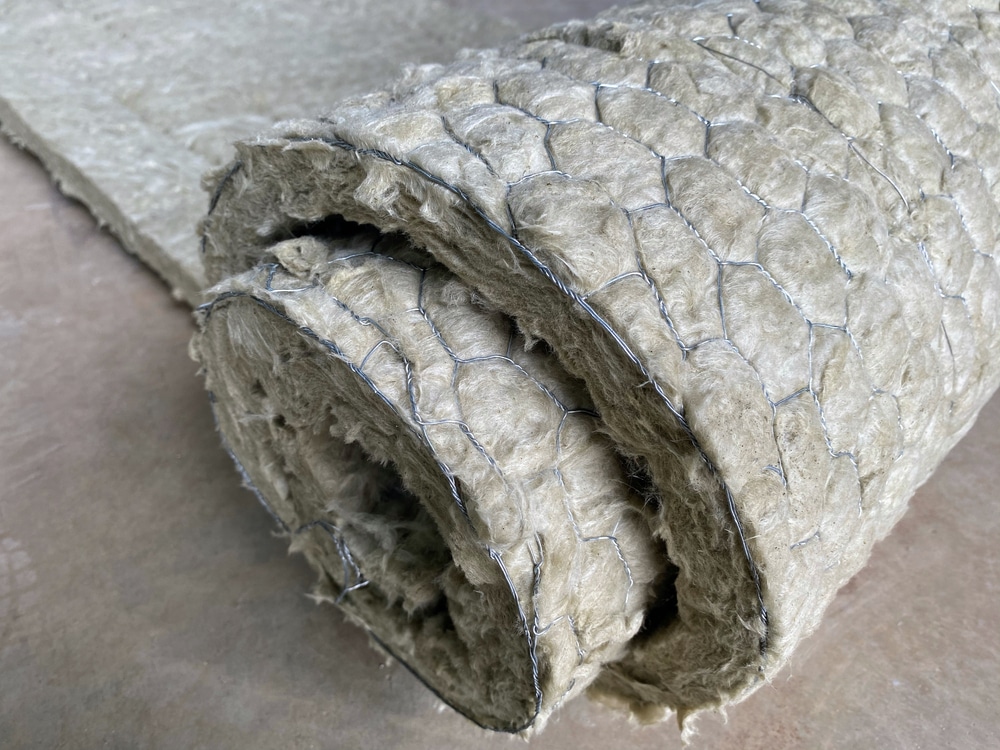Through much of the 20th century, asbestos was an integral component of insulation in residential, commercial, and industrial applications. Though it provided remarkable resistance to fire and heat, it was also responsible for exposure, illness, and deaths. Asbestos in insulation has been linked to malignant mesothelioma, asbestosis, asbestos-related lung cancer, and other illnesses.

What Is Asbestos?
Though it’s often referred to as though it’s a single mineral, asbestos is a family of six distinct fibrous silicate minerals, including chrysotile, amosite, crocidolite, tremolite, actinolite, and anthophyllite. Each type shares a characteristic structure of microscopic fibers that can easily separate into thin, durable strands.
This shared physical property is what gives asbestos its characteristic strength, heat and fire resistance, and immunity to electrical and chemical damage. These properties made asbestos invaluable across numerous industries.
People have used asbestos for centuries, but the Industrial Age introduced many new applications for its use. Effective insulation for industrial, commercial, and residential purposes was one of the most widespread uses for asbestos.
Asbestos as Insulation
Though asbestos has been used since ancient times, its use in insulation began in the United States in the late 1800s, when the company that would eventually become Johns Manville first started selling the product.
Asbestos insulation offered significant improvements over previous options, which included everything from horsehair and hay to wool and textiles. While these products formed a barrier, asbestos’s physical properties and the structure of its fibers slow the transfer of heat and cold, helping buildings to maintain indoor temperatures.[1]
At the same time, its resistance to fire helped protect the structures and equipment that it was insulating. Asbestos’s strength and durability meant that it could last for decades without deteriorating. It represented a cost-effective, long-term solution.[2]
Asbestos was used in several different types and forms of insulation:[3]
- Block and foam insulation. Block insulation or foam board was used to insulate walls, floors, foundations, basement walls, and low roofs and attics. It is made of rigid panels that were often composed of pure compressed asbestos and glued into place.
- Loose-fill insulation. Loose-fill insulation was blown into attics and wall cavities using specialized tubes. It looks like small, fluffy pellets and is easily disturbed, making it extremely difficult to avoid inhaling asbestos fibers.
- Spray Insulation. Spray-on asbestos was used for fireproofing, soundproofing, and thermal insulation, and was frequently used on ceilings, walls, ductwork, and pipes. It was sprayed on in liquid form, and in time it expanded and hardened to fill gaps. Its asbestos content was as high as 85%, and it is easily disturbed.
- Blanket insulation. Blanket insulation came in pre-cut sections and rolls and was used to insulate attics, walls, ceilings, and pipes.
- Vermiculite. Vermiculite insulation was made of heat-treated mica flakes. It was sold under the brand name Zonolite and was made of tremolite or actinolite asbestos, which is particularly dangerous. It resembles gravel and is often a glittery brown or silvery gold color.
What Makes Asbestos Insulation So Dangerous?
The danger of asbestos lies in its microscopic fibers, which can become airborne when disturbed. Asbestos fibers pose severe health risks when inhaled or ingested.
While intact asbestos-containing materials with properly encapsulated fibers (known as non-friable asbestos) are relatively safe, damage to these materials can release dangerous fibers into the air, creating exposure risks for anyone in the vicinity.
Asbestos-containing insulation is particularly prone to damage that releases fibers. It is rarely encapsulated, and its removal frequently involves cutting, drilling, sawing, or in some other way manipulating it so that asbestos fibers are released.
Mesothelioma and Other Cancers
Inhaled asbestos fibers persist in body tissues, especially the lining of the cavities that hold the lungs and peritoneal organs. This can trigger tissue damage, inflammation, and cell death that can lead to scarring, mutations, the growth of tumors, and other serious health conditions that may not become apparent until years or even decades after exposure.
All forms of asbestos are confirmed carcinogens, and exposure has been linked to several types of cancer. The most notable and dangerous is malignant mesothelioma, a rare and aggressive form of cancer that affects the mesothelium, a protective tissue lining that surrounds most internal organs.
While pleural mesothelioma (affecting the lung lining) is the most common form of the disease, mesothelioma can also develop in the mesothelium surrounding the abdominal organs, the cavity that holds the heart, or the testicles. Mesothelioma is typically diagnosed in advanced stages and has an extremely poor prognosis.
Exposure to asbestos insulation also increases the risk of lung cancer and may contribute to cancers of the gastrointestinal tract, throat, kidney, gallbladder, and esophagus, among others.
Asbestosis
It can also cause non-cancerous but serious conditions, including the progressive lung disease asbestosis, which develops after inhaled fibers cause irreversible scarring of lung tissue. Asbestosis causes breathing difficulties, chronic cough, and chest discomfort, and its symptoms worsen over time.
Other Asbestos Illnesses
Exposure to asbestos insulation can also result in pleural plaques and thickening. In these conditions, the lung lining becomes thickened and hardened, restricting lung function.
Pleural effusion, an uncomfortable accumulation of fluid around the lungs, has also been associated with asbestos insulation exposure.
Is Asbestos Insulation Still Around Today?
Asbestos insulation was used extensively between the 1930s and 1980s. Though the dangers of asbestos were publicized in the mid-1970s, by that time the product was installed in almost every structure in the United States, and much of that remains.
According to the Penn Medicine Abramson Cancer Center, approximately 30 million homes and buildings in the United States still contain some form of asbestos-containing material. For most of these, this legacy asbestos is contained in asbestos that was used to insulate walls and ceilings, attics, basements, ductwork, equipment, or pipes.
Though asbestos that is in good condition generally does not pose a threat, it becomes dangerous when it is disturbed during home improvements or renovations, or as a result of flooding, fire, or some other similar incident.[4]
In its final Risk Evaluation for Asbestos Part 2: Supplemental Evaluation Including Legacy Uses and Associated Disposals of Asbestos report, the U.S. Environmental Protection Agency identified asbestos pipe wraps and insulation containing asbestos as posing an unreasonable risk to human health.
This insulation is particularly dangerous to workers “involved with cutting, sanding, or grinding asbestos-containing material on a regular basis, such as construction workers who are routinely involved in demolition work.”
They also point to first responders such as firefighters, the family members of exposed workers who risk bringing fibers into their homes on their clothing, and people engaged in do-it-yourself home renovation or projects involving the removal of asbestos-containing materials such as insulation.[5]
Asbestos insulation that remains in place is generally found in the following locations:
- Boilers and furnaces
- Ceilings
- Ductwork
- Electric motors
- Electrical wiring
- Engines
- Floors
- Water heaters
- Kilns
- Pipes, valves, and ducts
- Stoves
- Turbines
- Walls
- Wood stoves
Exposure to asbestos insulation is frequently a work-related risk. Insulation professionals, demolition workers, firefighters, and construction workers are at particular risk, but so too are homeowners whose homes were built before 1990.
Older homes may have asbestos hidden behind walls and in attics. To tell whether your home’s insulation contains asbestos, it’s a good idea to familiarize yourself with what asbestos insulation looks like:[6]
- Spray-on insulation is usually gray and is found on the ceilings of basements or attics, while loose-fill insulation is fluffy or granular, and does not have a paper backing.
- Block insulation looks like boards and is usually glued to walls.
- Blanket or wrapped pipe insulation is found in basements, furnace rooms, and utility rooms, and looks like either corrugated cardboard wrapped around pipes or like a fluffy wool.[6]
Do not attempt to remove asbestos insulation yourself. The best way to address it is to contact a licensed asbestos abatement professional who will test it to see whether it contains asbestos and then either encapsulate it or remove it in compliance with applicable regulations.
Will I Get Sick if My Home Contains Asbestos Insulation?
Fortunately, most people living in homes with old asbestos won’t suffer significant exposure. As long as the asbestos insulation is contained and in good shape, it should not be shedding fibers.
Any asbestos exposure is dangerous, but not everyone who comes close to asbestos fibers will develop health problems. Mesothelioma is strongly associated with asbestos exposure, but it is also extremely rare. The likelihood of developing an asbestos-related illness depends on several key factors.
Risk increases based on both the concentration of fibers and duration of exposure. Higher doses over longer periods increase the risk.
The specific type of asbestos you’re exposed to matters too, with blue (crocidolite) and brown (amosite) varieties generally posing higher risks than white (chrysotile) asbestos.
Additional risk factors like smoking substantially increase the chance of developing lung cancer when combined with asbestos exposure, and genetic predisposition may also influence your susceptibility to asbestos-related diseases.
Who Is at Risk for Illness from Occupational Exposure to Asbestos Insulation?
The majority of people diagnosed with asbestos-related diseases are those who are exposed to the carcinogenic material on the job.
The occupational exposure risks posed by asbestos affect a wide range of professionals:
- Boiler workers
- Building inspectors
- Carpenters
- Construction workers
- Demolition workers
- Drywallers
- Electricians
- Engineers
- Firefighters
- Furnace workers
- Insulators
- Laborers
- Maintenance workers
- Millwrights
- Pipefitters
- Plumbers
- Shipyard workers
- Steamfitters
In a notable study of 632 insulation workers who entered the field before 1943 and who were traced through 1962, researchers found that 45 died of cancer of the lung or pleura, where only 6.6 such deaths were expected.
This is an exceedingly high incidence of these rare cancers and an indication of the extreme danger that asbestos insulation poses to human health.[7]
In addition to the risks faced by these workers, there is also a real risk of illness for their family members who may have suffered second-hand asbestos exposure from asbestos insulation fibers brought home on hair, skin, or clothing.
If your work has the potential of exposing you to asbestos insulation, you are strongly encouraged to educate yourself about the risks and take workplace training.
The Occupational Safety and Health Administration (OSHA) has established standards for asbestos exposure in the workplace and requires employers to assess risk, maintain acceptable air quality, and provide safety training for workers at risk of asbestos exposure.[8]
You should also take advantage of any safety gear that’s provided. If your employer does not comply with OSHA standards, you can file a complaint.
What Should I Do if I Was Exposed to Asbestos?
If you’ve been exposed to asbestos insulation, it’s a good idea to notify your healthcare provider of your history, especially if your exposure encompasses an extended period. Mesothelioma and other asbestos-related diseases are relatively rare, and providing this information will encourage your doctor to monitor your health for troubling signs.
If you have concerning symptoms, you may need to seek specialized care from a doctor who is familiar with mesothelioma. Taking a proactive approach can make a real difference, leading to earlier diagnosis and treatment.
What Should You Do If You’re Diagnosed with Mesothelioma?
If you worked with or were exposed to asbestos insulation and you’ve been diagnosed with mesothelioma or another asbestos-related disease, you have several options.
Though your first step should always be seeking medical help, once you have a treatment plan in place, consult with an experienced mesothelioma attorney. A lawyer can provide you with valuable information about filing a personal injury lawsuit, filing a claim with an asbestos trust fund, and the availability of other types of compensation and benefits.
Lawsuits and Settlements
If you’ve been hurt as a result of exposure to asbestos insulation, one of the most effective ways of seeking justice and compensation is to file a personal injury lawsuit against the companies responsible for manufacturing, selling, and distributing asbestos insulation.
An experienced asbestos attorney will analyze your work history to help you identify the specific companies whose products you were exposed to.
Though the idea of a trial may be intimidating, most asbestos lawsuits end up being resolved in out-of-court settlements.
Asbestos Trust Funds
Many companies that faced asbestos lawsuits were ordered to pay millions in compensation to victims and their survivors. Those that were forced into bankruptcy by their significant liabilities were required to establish trust funds specifically to compensate victims.
Accessing these funds requires filing a claim documenting your asbestos exposure, and a mesothelioma attorney can help you identify the funds for which you may be eligible and guide you through the process.
Asbestos Insulation Companies
Hundreds of companies manufactured, distributed, or in some other way supplied asbestos insulation:
- Armstrong Worldwide
- Certainteed Corporation
- Celotex
- Combustion Engineering
- Crown Cork & Seal
- E. Thurston & Sons
- EaglePicher
- Ehret Magnesia
- E.J. Bartells Company
- GAF Corporation
- Garlock Sealing Technologies
- Johns Manville
- Kaiser Aluminum
- Keasbey & Mattison
- Metalclad Insulation Corporation
- National Gypsum
- Nicolet
- Owens Corning
- Owens-Illinois
- P. Green Industries
- Pacor Incorporated
- Pittsburgh Corning
- Quigley Co.
- Rock Wool Manufacturing
- Shook & Fletcher
- The Flintkote Company
- Unarco
- United States Gypsum Company
- Western MacArthur
- W.R. Grace
Compensation for Veterans
Many victims of exposure to asbestos insulation encountered it during their military service. This is especially true of Navy veterans because of the extensive use of asbestos insulation on Navy ships.
Veterans diagnosed with mesothelioma may qualify for compensation through the Veterans Administration (VA), including disability compensation and specialized health care at VA medical centers.
References
- Ascend Construction (2023, September 4). Insulation Archaeology: A Look at Historical Methods of Home Insulation.
Retrieved from: https://www.ascendconstruction.net/history-of-insulation/ - Superior attic. (n.d.). Unveiling the Mystery: Understanding Asbestos Insulation.
Retrieved from: https://www.superiorattic.com/post/what-does-asbestos-insulation-look-like - JSE Labs. (2021, June 30). How to Identify Asbestos Insulation in Walls & Attics.
Retrieved from: https://jselabs.com/blog/asbestos-insulation/ - Penn Medicine. (n.d.). Asbestos Exposure and Cancer.
Retrieved from: https://www.pennmedicine.org/cancer/types-of-cancer/mesothelioma/causes-risks-prevention/what-is-asbestos - U.S. Environmental Protection Agency. (November 27, 2024, November 27). EPA Finalizes Part 2 TSCA Risk Evaluation for Asbestos.
Retrieved from: https://www.epa.gov/chemicals-under-tsca/epa-finalizes-part-2-tsca-risk-evaluation-asbestos - The Spruce. (2025, February 4). Asbestos Insulation: Identification and What to Do. The Spruce.
Retrieved from: https://www.thespruce.com/how-to-identify-dangerous-asbestos-insulation-4119906 - Selikoff, I.J., Churg, J., and Hammond, E.C. (1984). Classics in Oncology: Asbestos Exposure and Neoplasia. CA Cancer J. Clin. 34(1), 48-56.
Retrieved from: https://pubmed.ncbi.nlm.nih.gov/6420020/ - Occupational Safety and Health Administration. (n.d.). Asbestos.
Retrieved from: https://www.osha.gov/asbestos

Terri Heimann Oppenheimer
WriterTerri Oppenheimer has been writing about mesothelioma and asbestos topics for over ten years. She has a degree in English from the College of William and Mary. Terri’s experience as the head writer of our Mesothelioma.net news blog gives her a wealth of knowledge which she brings to all Mesothelioma.net articles she authors.

Dave Foster
Page EditorDave has been a mesothelioma Patient Advocate for over 10 years. He consistently attends all major national and international mesothelioma meetings. In doing so, he is able to stay on top of the latest treatments, clinical trials, and research results. He also personally meets with mesothelioma patients and their families and connects them with the best medical specialists and legal representatives available.


